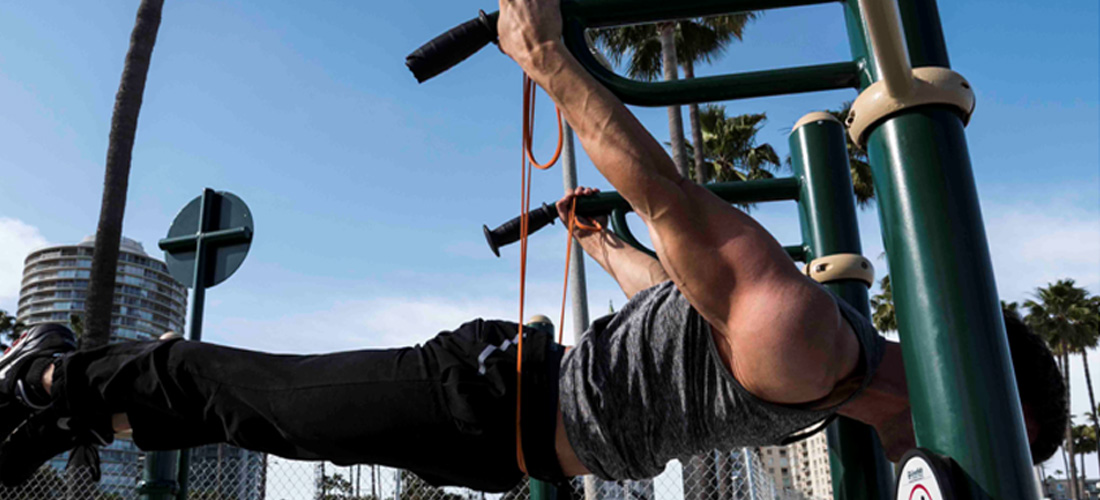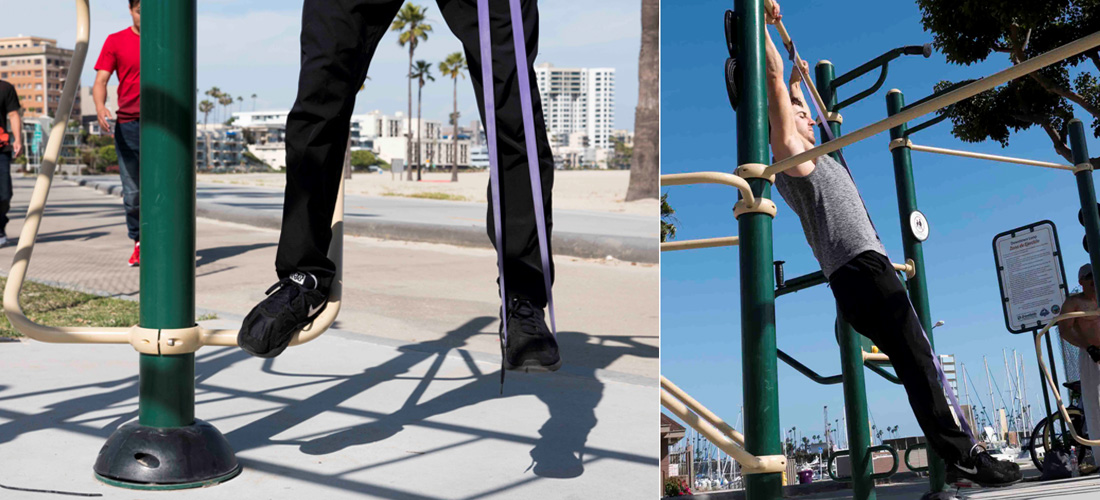
4 July 2017 10 Best Resistance Band Bodyweight Exercises
Resistance bands are continuous bands of strong rubber commonly utilized by the fitness industry. They are light, easy to store and great for home workouts or when traveling. Being elastic, they want to maintain their original shape and therefore provide resistance when stretched. This resistance means the bands have many applications for strength training. They can be used to mimic conventional weight training exercises, for example, bicep curls. They can be employed as accessory equipment for conventional weight training to increase or reduce the difficulty of exercises. They can be used to target positional weaknesses. And last but not least,they are simple and extremely effective tools that can be used for bodyweight training exercises.
Bands come in varying levels of resistance – using a thicker band will provide more resistance, hence making exercises more difficult when fighting against the band, and making exercises easier when using the bands to assist you. Likewise, the further you stretch a band the more resistance (or assistance) it will provide.
Below are 10 of my favorite bodyweight strength training exercises that utilize resistance bands.
1. SQUATS
Lower limbs are an area that can be difficult to target with bodyweight exercises alone and are therefore often neglected. I recommend using compound lower limb resistance training exercises (such as barbell squats) to supplement your bodyweight training. Resistance bands can be a great alternative to weight training, especially when traveling or when equipment is not available.
To perform resistance band squats, place a band on the floor and step over the center of it. Squat down, pick up each end and stand up tall. Lower down and repeat. To increase the difficulty, reduce the length of band between your foot and hand. Make sure the band is taut at the bottom of the squat to provide resistance throughout the entire movement.

2. BAND ASSISTED PLANCHE
Wrap a band from a horizontal bar (e.g., a pull-up bar) and hook the loop onto your hip bones. Once the band is in position, slowly lift into a tuck planche. From here you can progress to more difficult variations such as the advanced tuck, straddle or full planche positions. This can be used to familiarize yourself with advanced planche positions you cannot yet hold. You can also practice assisted planche push-ups in each position. As the band does not hold your feet with this method, you will be working your back and gluteal muscles to keep your hips extended.

3. BAND ASSISTED FRONT LEVER
Wrap a band from a horizontal bar. Hang from the same bar with your hands either side of the band and the band hooked onto the bottom of your foot/feet (you can have a partner assist you to position the band). From here, pull your scapulae (shoulder blades) down and back and slowly lift to a tuck lever position. This can be made more challenging by progressing to an advanced tuck front lever, a single leg front lever,and finally a full front lever. To ensure the band is taut and providing adequate assistance for the tuck front lever, you can hang the band from an anchor point behind your hands, as shown in the photo below. Front lever band exercises can be performed as isometric (static) holds, or for repetitions, moving between a hang and front lever.

4. BAND ASSISTED ONE-ARM CHIN-UP
There are many exercises that can be utilized to train for one-arm chin-ups. One of these is a band assisted one-arm chin-up. Hang the band from a bar, hold it in one hand, and grip the bar with the other. From here perform a chin-up so that your chin rises above the hand gripping the bar. The closer to the bar you grip the band, the easier the exercise will be. As you get stronger, try to progressively lower where your hand grips the band. A good way to monitor your progress is to measure or mark how low you are holding the band.

5. HUMAN FLAG
To perform the human flag with a band, position the band high above where your hands will be positioned on the pole. Alternatively, if there is an anchor point above where your feet will be positioned in a flag, you can attach the band here. You may require a partner to assist you to place the band around your feet as you attempt to enter the flag position. From here you can try straddle or full flag positions.

6. BAND PULL-UP/CHIN-UP
This is a great exercise to help develop the muscles used in a pull-up/chin-up, especially for those who are unable to do these unassisted. Wrap a band from a horizontal bar. Hang from the same bar with your hands either side of the band and the band hooked onto the bottom of your feet (you can have a partner assist you to position the band). From here, set your scapulae (shoulder blades) by pulling them down and back, and perform a pull-up. The band will provide less assistance as your rise to the top position.

7. DIPS
ASSISTED (EASY)
For those who are unable to perform dips unassisted, a resistance band can be utilized to assist your dip. Position the band between the bars and position your hand over the band on each bar to secure it. From here, position your knees on the band and perform a dip. You can have a partner help position the band for you.
RESISTED (DIFFICULT)
Position the band between the bars and rest your hand over the band on each bar to secure it. From here, start at the bottom position of a dip with the band resting above your shoulders as a barbell does in a back squat. As you rise the band will resist your movement, making it more difficult.

8. PUSH–UPS
ASSISTED (EASY)
Similarly to dips, for those who cannot perform a push-up or knee push-up unassisted, a band-assisted push-up can help you build the strength required to do so. Hang a band from a bar above you and position the band looped around your chest so it is directly below the anchor point when you are in the push-up position. The band will provide more assistance the lower you go in the push-up.
RESISTED (DIFFICULT)
Place the band around your back and secure it under your hands on each side. Pull the band so it is taught at the bottom position in a push-up. The band will progressively provide more resistance as you rise.

9. BACK LEVER
This can be done on rings or a bar. The back lever is easier to enter on rings or separate bars, as you do not have to navigate around a bar between your hands.
Start with the band positioned between the rings/bars and secured by gripping with your hands. From here position (or have a partner assist you to position) the band on your hip bones and lower into a lever. You can lower into a tuck, advanced tuck, straddle or full back lever with increasing difficulty. The band will provide assistance as long as it is pulled taught. To reduce the range that it assists you with, simply put some slack in the band so it is not pulled taught until part way into the lever.
Similarly to the band planche exercise, as this method assists from the hips, you are still required to use your back and gluteal muscles to keep your hips extended.
Back lever band exercises can be performed as isometric (static) holds, or for repetitions, moving between an inverted hang and back lever.

10. MUSCLE UP
A muscle up can be performed on the rings or a bar using slightly different techniques. This band-assisted muscle up is demonstrated on a bar.
The bar muscle up differs from the ring muscle up in that you cannot lift your head in a vertical manner as you would hit the bar. To clear the bar, the head/upper torso must pass behind the bar during the pull-up portion, and then lean forward over the bar during the dip portion. As a result, the bar muscle up is performed with a slight, arc like motion. To perform this with a band, you can start standing on a box or object positioned on the floor slightly behind the bar. Grip the bar so the band is hanging between your hands and secure one foot in the band. From here, step off the box and propel yourself forward slightly as you lower. Notice the feet drift in front of the bar at the bottom of the motion. Just as the body begins to swing back, commence the pulling phase. As you commence the pulling action to rise, the band will assist to pull you back and up over the bar.



Akash Dutta
Posted at 05:33h, 18 OctoberWow…..those are some cool exercises…..thx simon …
Fernando
Posted at 05:19h, 18 AugustGreat information!! I’ll add some of this exercises to my routines! 🙂
Fabian Manzano
Posted at 04:31h, 03 MarchFor the band planche what do you think it is best, to have it in the heaps or in the feet?
Simonster
Posted at 21:52h, 06 MarchHips as you must extend your hips against gravity actively, better mimicking the planche.
Katerina Chatzinikolaou
Posted at 07:35h, 22 NovemberI already use some of these but I saw a couple I didn’t know, thank you Simon